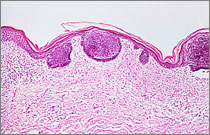Anal cancer
| 2022 | ||
|---|---|---|
¹ per 100,000 persons, age-standardised according to the old European standard population * until 1.12.2020 ** calculated using the period method for 2019 / 2020 | ||
| Women | Men | |
| Incidence | 1,622 | 952 |
| Age-standardised incidence rate¹ | 2.4 | 1.6 |
| Deaths | 346 | 248 |
| Age-standardised mortality rate¹ | 0.4 | 0.4 |
| 5-year prevalence* | 5,800 | 3,000 |
| 10-year prevalence* | 9,200 | 4,600 |
| Relative 5-year survival rate** | 72 % | 63 % |
| Relative 10-year survival rate** | 68 % | 60 % |
Cancers of the anus are predominantly squamous cell carcinomas. In 2022, approximately 2,574 people, including 1,622 women, were newly diagnosed. Contrary to the decreasing rates of colorectal cancer, both the incidence rate and the mortality rate from anal carcinoma have risen substantially over the past 15 years. Other countries have also reported an increase in incidence. The relative 5-year survival rates with cancer of the anus for women and men are 72 percent and 68 percent, respectively.

![]() Age-standardised incidence and mortality rates by sex, ICD-10 C21, Germany 1999 – 2017/2018, projection (incidence) through 2022, per 100,000 (old European standard population)
Age-standardised incidence and mortality rates by sex, ICD-10 C21, Germany 1999 – 2017/2018, projection (incidence) through 2022, per 100,000 (old European standard population)
Human papillomaviruses are the most important risk factor
In Germany, about 90 percent of anal carcinomas can be traced back to an infection with human papillomaviruses (HPV). Other risk factors are smoking, certain sexual practices (frequently changing sexual partners, passive anal sex) and chronic immunosuppression. The risk of developing anal carcinoma is much higher among HIV-positive persons, especially among HIV-positive men who have sex with men, than in the general population.
Date: 30.12.2024






